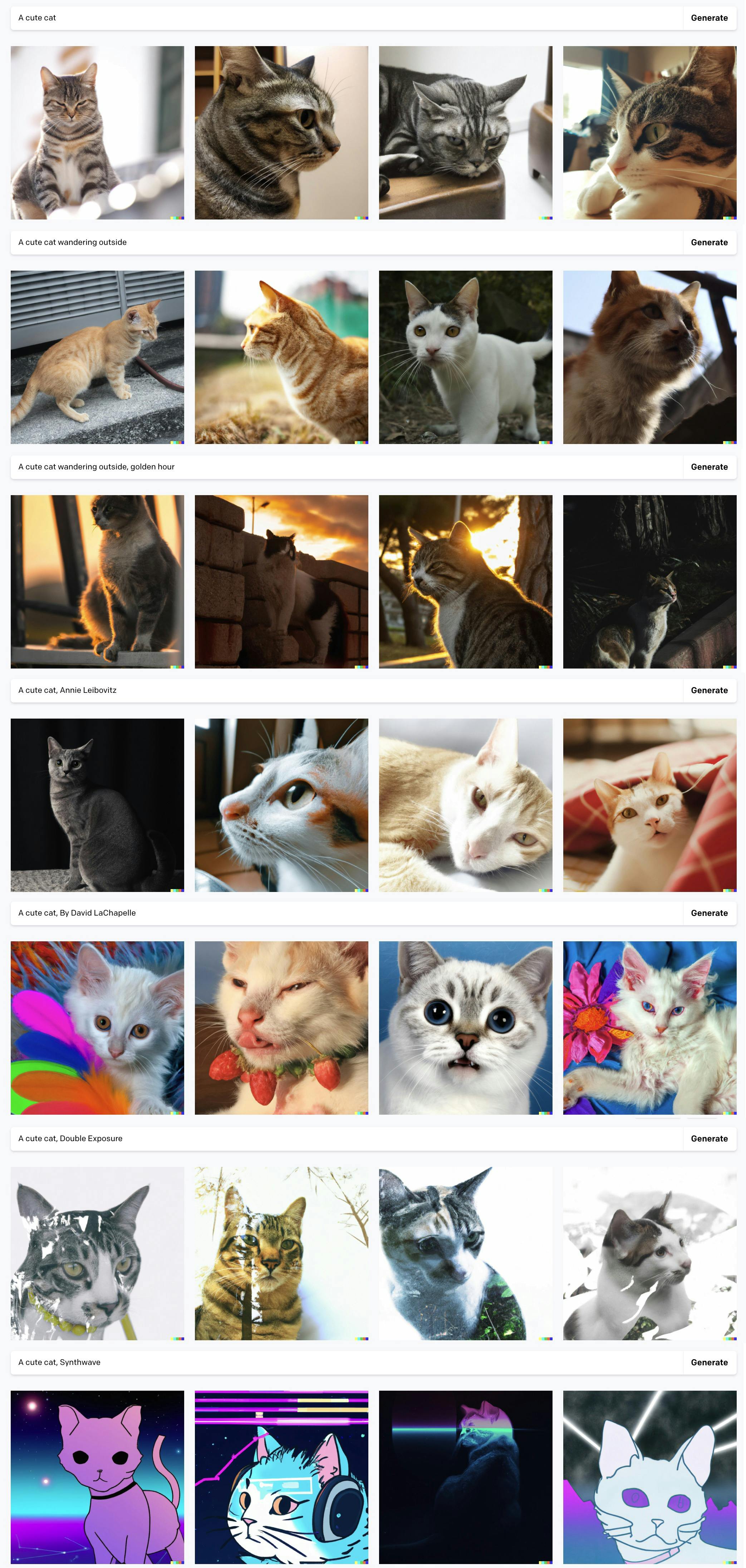The current state of AI for content creators
The current state of AI for content creators
By Vince Liem and OpenAI GPT-3
6 min read
In the second part of this series, we will take a look at some of the ways that GPT-3 can be used by content creators to improve their workflow. We will also provide some tips on how to get started with using GPT-3 for your own projects. We will use OpenAI’s Playground to try out the features of GPT-3.

- Authors

- Name
- Vince Liem

- Name
- OpenAI GPT-3
The author generated this text in part with GPT-3, OpenAI’s large-scale language-generation model. Upon generating draft language, the author reviewed, edited, and revised the language to their own liking and takes ultimate responsibility for the content of this publication.
You can create your account for GPT-3 at beta.openai.com and Dall-e at labs.openai.com.
"We" meaning me and the robot occupying space in my laptop.
As a content creator, you are always looking for new ways to optimize your workflow and get the most out of your content. With the release of OpenAI’s GPT-3, there is now a powerful tool that can help you with both of these things: natural language processing.
Natural language processing (NLP) is a field of computer science and artificial intelligence focused on the interactions between computers and human (natural) languages. In other words, it’s all about teaching computers how to understand human language.
GPT-3 is a state-of-the-art NLP model that has been designed specifically for Natural Language Understanding (NLU). NLU is different from traditional NLP in that it focuses on understanding the meaning of text, rather than just recognizing patterns or performing statistical analysis.
Get a list of topics you can talk about

One of the most useful applications of GPT-3 for content creators is its ability to generate a list of potential topics that you can write about. This is especially helpful when you are feeling stuck for ideas, or if you want to explore a new topic that you are not familiar with.
Simply enter in a prompt such as “I am a travel blogger visiting Japan, here are some topics I want to write about:” then add a dash in the next line to indicate that it is a list and GPT-3 will start generating potential topics that you could write about, based on your input.
TIP: Don’t add a space or a new line at the end of your prompt, always end the prompt with your last character.
I am a travel blogger visiting Japan, here are some topics I want to write about:
-
After pressing “Submit”, GPT-3 completed the prompt for me and suggested the following topics.
I am a travel blogger visiting Japan, here are some topics I want to write about:
- The best places to visit in Japan
- The best food to eat in Japan
- What to expect when visiting Japan
- A guide to Japanese culture
- The top things to do in Japan
Summarize other articles and get keywords

If you are a content creator who writes about technical topics, then GPT-3 can be a valuable tool for helping you to summarize other articles and get keywords that you can use in your own content.
Simply enter in a prompt such as “#### Summarize this article for me” followed in a new line by “## Article”, two new lines and a copy of the article that you want to summarize.
TIP: Using 2 hashtags is the most optimized way for GPT-3 to indicate different sections and 4 hashtags to indicate an instruction.
#### Summurize this technical article
## Article
Test-driven development (TDD) is a software development process relying on software requirements being converted to test cases before software is fully developed, and tracking all software development by repeatedly testing the software against all test cases. This is as opposed to software being developed first and test cases created later.
Software engineer Kent Beck, who is credited with having developed or "rediscovered" the technique, stated in 2003 that TDD encourages simple designs and inspires confidence.
Test-driven development is related to the test-first programming concepts of extreme programming, begun in 1999, but more recently has created more general interest in its own right.
Programmers also apply the concept to improving and debugging legacy code developed with older techniques.
## Summary
Go ahead and press “Submit” and GPT-3 will automatically generate a summary of the article for you that you can use in your own content. Your summary will look different than mine.
[...]
## Summary
Test-driven development is a software development process in which test cases are created before software is developed, and all software development is tracked by repeatedly testing the software against those test cases. The goal of TDD is to encourage simple designs and inspire confidence in the code being developed.
TIP: After you’ve pressed “Submit”, that doesn’t mean that it’s the end of it. You can keep adding to the prompt - a new instruction, section, or add to the Article itself.
So I’ve added “## SEO keywords” under the output and pressed “Submit” to get a list of keywords.
[...]
## SEO keywords
-Test-driven development
-TDD
-Software development process
-Test cases
-Software testing
-Quality assurance
Turn freeform writing into structured content

If you are a content creator, you know the struggle of brainstorming ideas and then trying to piece them together into a structured article. It can be frustrating when your brilliant ideas turn into an incoherent mess. However, with GPT-3 you can take your freeform writing and turn it into structured content.
The AI will analyze your writing and pick out key concepts and ideas. It will then organize these concepts into a structure that makes sense. This will save you time and energy in the brainstorming and drafting process. Additionally, it can help you to create more cohesive and well-organized articles.
Since I don’t have brilliant ideas on the shelf that I can turn into an incoherent mess — In this next example I will use a transcription of a phone job interview.
#### Structure the following transcription about working at a company into a professional CV entry
## Phonecall
CV Maker (Interviewer): Can you tell me a bit about your previous work and what you did there?
Interviewee: I worked at a forex trading bot platform for about six months. It was quite challenging for me. My job as a front-end developer was to create components using storybook and react then lego them together in the main repository. The challenge wasn't the work itself though. It was management that was too inexperienced in their jobs. Basically they made enough money through trading in forex, but that didn't automatically translate into leadership skills when they started hiring employees. So yeah, that's why I wanted to leave there. Because I wanted to make so much other things. They promised that we could develop the first forex trading platform on the blockchain. So I've designed a technical architecture to support such an idea. But it never came into fruition because legal department didn't want the hassle of dealing with blockchain. And they cut the project. So that's why I wanted to leave.
## CV entry
-
After pressing “Submit” it generated the following.
[...]
## CV entry
- **FX Trading Platform** (6 months) - I worked on a forex trading bot platform for about six months. My job as a front-end developer was to create components using storybook and react then stitch them together in the main repository. I also designed a technical architecture to support an idea for a forex trading platform on the blockchain, but the project never came to fruition.
Combine multiple topics into a single topic

If you have written everything you can about a single topic, then the next step might be that you want to integrate it with a completely different topic to create something new and fresh. With GPT-3, you can do just that!
First enter the instruction of what you intend to do, following the first topic, then the second topic (both topics must have a little bit of overlap for this to prevent odd results) and GPT-3 will automatically start combining both topics for you.
#### Combine these different topics into an entirely new topic
## Topic 1: Smart homes
Smart homes are houses equipped with technology that allows the home's systems to be controlled remotely. This can include things like thermostats, security systems, and lighting. Smart homes often use voice-activated assistants like Amazon's Alexa or Google Home to make controlling the house more convenient.
One benefit of smart homes is that they can save energy by automatically adjusting heating and cooling based on occupancy and temperature outside. They can also improve home security by allowing homeowners to monitor their property remotely and receive alerts if there is unusual activity.
## Topic 2: Cruelty-free zoo
A cruelty-free zoo is a zoo that does not keep animals in captivity. Instead, they focus on conservation and education. These zoos often have more naturalistic habitats for the animals and may also rescue animals from abusive situations.
One advantage of cruelty-free zoos is that the animals are not confined to small spaces or put on display for humans to gawk at. They are also typically not subjected to cruel training methods or other abuse. This can result in a happier and healthier animal population overall.
## Combined topic: How a smart zoo can create a cruelty-free home for animals
TIP: You don’t have to write your own description of these individual topics. You can let the AI do it, at least I did for this example.
I hope that you’re as curious as I am how these subject will combine. Let’s press the “Submit” button to see what it generates.
[...]
## Combined topic: How a smart zoo can create a cruelty-free home for animals
A smart zoo is a cruelty-free zoo that uses technology to create naturalistic habitats for animals. This can include things like sensors that track the animals’ movements and environmental conditions, and virtual reality that allows visitors to experience the habitat without actually being there.
The benefits of a smart zoo include improved animal welfare due to less confinement and fewer harmful training methods or other forms of abuse. The technology can also help with conservation efforts by providing data about animal behavior and populations.
Dall-e

Did you enjoy the images in this blog? Well do I have news for you. All these images are generated by Dall-e, OpenAI’s large-scale artificial intelligence model for generating images from natural language descriptions.
That way you can quickly turn your thoughts into images by writing prompts for Dall-e. (Dall-e can be found at https://labs.openai.com - currently it's in invite only)
15mm wide-angle lens photo of a rapper in 1990 New York holding a kitten up to the camera

a man in a business suit holding a briefcase and a cat

Why not combine GPT-3 and Dall-e by letting GPT-3 describe something intangable and complex like hope.
#### Write a short prompt of a picture that displays hope
a group of people of different races and genders holding hands in front of a sun setting over a cityscape

#### Write a short prompt of a picture that displays consciousness
a person floating in space with their eyes closed and a thought bubble above their head containing a image of a brain

Here are some examples of cute cats and its prompts.

Conclusion
In this blog post, we have looked at some of the ways that GPT-3 can be used by content creators to improve their workflow. We have also provided some tips on how to get started with using GPT-3 for your own projects. We have used OpenAI’s Playground to try out some of the features of GPT-3.
If you are a content creator, then we hope that you found this blog post helpful. GPT-3 is a powerful tool that can help you to save time and improve the quality of your content.